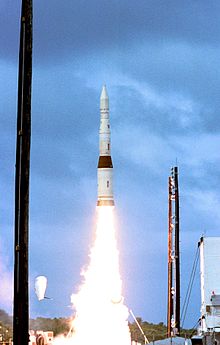- Payload Launch Vehicle
-
Payload Launch Vehicle (kurz PLV, dt. Nutzlast-Start-Träger) war eine suborbitale Erprobungsrakete für die Raketenabwehr-Gefechtsköpfe der National Missile Defense.
Aufbau
Die PLV-Rakete besteht aus der zweiten (SR-19) und dritten Stufe (M-57A1) von abgerüsteten Minuteman-II-Interkontinentalraketen, die von Lockheed Martin und dem Unterauftragnehmer Space Vector Corporation umgerüstet wurden. Anstelle des ursprünglichen nuklearen Sprenkopfs der Minuteman-Rakete verwendet die PLV einen in eine Nutzlastverkleidung eingeschlossenen kinetischen Gefechtskopf. Dieser als Exoatmospheric Kill Vehicle bezeichnete Gefechtskopf wird außerhalb der Erdatmosphäre von der PLV-Rakete abgetrennt und manövriert sich auf einen Kollisionskurs mit dem anfliegenden Sprengkopf.
Alle Starts erfolgten von einem aus einem Raketensilo bestehenden Startkomplex auf Meck Island im Kwajalein-Atoll. Von 1997 bis 2002 fanden insgesamt zehn Starts statt, davon zwei Fehlschläge.
Für das operationelle Ground-Based Interceptor-System wurde mit der OBV-Rakete eine neue Startrakete entwickelt.
Ähnliche Raketen, die ebenfalls auf der Kombination aus SR-19- und M-57A1-Stufen der Minuteman-II-Rakete bestehen, sind die von Coleman Aerospace modifizierte Hera-Zieldarstellungsrakete und die von Orbital Sciences Corporation modifizierte SR-19 M-57A1.
Starts
Nr: Startdatum Test Erfolg 1 23. Juni 1997 IFT-1A 2 15. Januar 1998 IFT-2 3 3. Oktober 1999 IFT-3 4 19. Januar 2001 IFT-4 5 8. Juli 2000 IFT-5 Teilerfolg; Kinetischer Gefechtskopf wird nicht abgetrennt 6 15. Juli 2001 IFT-6 7 4. Dezember 2001 IFT-7 8 16. März 2002 IFT-8 9 15. Oktober 2002 IFT-9 10 11. Dezember 2002 IFT-10 Teilerfolg; Kinetischer Gefechtskopf wird nicht abgetrennt Quellen
Kategorie:- Raketentyp
Wikimedia Foundation.


